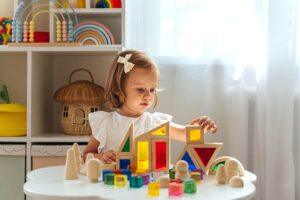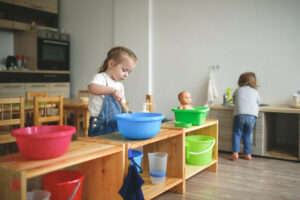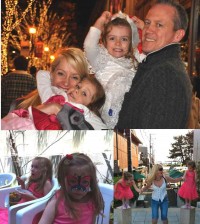- Belgium comes to Yamashita Park
- Residential Villa in Phuket Entices Remote Workers With Long-Stay Rates
- Rare pieces of French glass art at the Mirai Museum of Art
- Feast on fresh fish and seafood at the 2024 ‘Sakana’ Festival
- Would you like to ride in a Louis Vuitton gondola lift?
- Naked Snow Aquarium
- Festive lights at Yomiuriland will get you feeling the holiday vibes
Giving your toddler a headstart the Montessori way

According to child development experts, toddlers begin stringing words into short phrases at age 2.
By age 3, they are able to link words and say longer phrases effortlessly.
Italian physician and educator Maria Montessori discovered that children from birth to age 6 learn in a different way than adults do. As they interact with their environment, they unconsciously absorb the details in their environment. These years cannot be overlooked and it is crucial that children in this age range get all the stimulation they can get in order to allow for certain parts of the brain to develop.
When Tokyo parents Francesco and Reiko’s daughter Reina turned 3, they decided it was time to go school shopping. Although this means saying goodbye to babyhood, they had to do what most parents do – check out a number of schools.
“I received a Montessori education in Italy until I was 12. I come from a Montessori clan. My mom and aunt are certified Montessori teachers,” says Franceso who works as an Engineer in Tokyo.
“I may be biased here,” he continues, “but I am a fan of ‘freedom’ and ‘learning by doing’. My Montessori background had, in many ways, pointed me to the right career direction and I simply want the same for my daughter. The only thing to consider for us now is the budget (laughs).”
“But when we consider what our daughter gets in return and how that perfectly aligns with a roadmap we believe empowers our child, the Montessori option makes the most sense for my family,” says Francesco.
One teacher said that if one wanted to find a fitting slogan to encompass Montessori education, “Follow the child” would be it.
In a typical Montessori setting, children have considerable freedom to do what they are curious about in a prepared environment. The job of keeping track of their strongest sensitive periods of development using Montessori principles belongs to teachers or ‘guides’. They are the bridge between your child and the prescribed materials and it is not enough that teachers know how to use them – they need an understanding of where each child is in his or her development.
Authentic Montessori schools have teachers trained to think more like scientists using observation as a core principle. They keep records of what your child is doing and continually evaluate and guide which areas they need to work on, and what the next steps are, following every stage of your child’s development in many nurturing ways.
The newly opened Dandelion Montessori School specializing in the 3-6 age group in the Minato ward is one such school. It is run by power couple Mariko and Pete whose rich experience in the Tokyo Montessori community spans over 30 years.
Like all authentic Montessori schools, Dandelion has a multi-age classroom, a key aspect of the Montessori education where young and older children have long blocks of uninterrupted learning and discovery time. While some parents may find such arrangement convenient, I know some families with two children that share the same reluctance over sending both to the same school for fear of fueling sibling rivalry – one outshining the other.
But Dandelion Montessori School co-founder Pete Juds reassures parents that that’s less likely to happen.
“Actually, we usually find it does the opposite. In a classroom of mixed ages and varying abilities, a non-competitive community develops, in which everyone learns from others and contributes to the good of the whole. The mix of ages and abilities helps children celebrate their own successes without comparing themselves to others.”
The Montessori curriculum centers on developing the child’s physical and motor skills, sensorial and perceptual skills, language, mathematics, self-help and social.
What are classrooms like?
In the bright, neat and sunny classroom where Reina goes every single day, children are free to choose activities they want to do, often called ‘work’. Children wash hands, peel and cut bananas or cucumbers using real, child-sized kitchen utensils. They are also given opportunities to care for themselves (wiping noses, changing shoes and clothes, etc.)
 Unlike traditional preschools, there are no medals or rewards for being the best at something in a Montessori setting. The ‘prize’ is the achievement of a goal that the child sets for himself. The success of being able to stack the blocks to sort them by size or pour water into an empty glass is the reward.
Unlike traditional preschools, there are no medals or rewards for being the best at something in a Montessori setting. The ‘prize’ is the achievement of a goal that the child sets for himself. The success of being able to stack the blocks to sort them by size or pour water into an empty glass is the reward.
In Montessori education, practice beats theory. Reina wanted to paint her paper ‘green’ which was not on her water color palette. After trying many mix-and-match attempts with her colors, she discovered by herself that she can produce one by mixing blue and yellow.
“Although she works alone most of the time, she joins older kids sometimes to dig up worms in the garden and talk about what they discover,” says Reina’s mom.
Montessori classrooms have a minimalist approach to ambiance with soft lights and naturally colored walls – a stark contrast from posters and decor in bright colors often pinned to traditional school walls.
Montessori materials are eco-friendly by design. The furnishings are essentially made of sustainable wood and may include metals and glass. The goal, according to Maria Montessori, is for children to learn certain concepts through sensorial exploration made possible by an environment closely rooted in nature. The idea of young children using breakables like real glasses for drinking and ceramic dishes might make parents feel uncomfortable. Don’t – they are there for a reason. It’s because these objects can break that children learn to predict what happens when they are not handled with care.
“We couldn’t have picked a better time to send our child to Montessori,” says Reiko. “In just 5 short months since starting Montessori, our daughter went through a remarkable developmental leap from throwing a fit when left alone to being able to interact independently with kids her age and older. I have observed too that my daughter now sleeps soundly even when I am not near her. I think she is getting accustomed to being more independent and that for us is huge.”
Is Montessori any better than traditional schools?
A review of Montessori-educated (preschool to high school) students by Campbell Collaboration compared Montessori and traditional schools to gauge who has better academic, social and emotional outcomes. These children from 8 countries come from different socio-economic backgrounds.
Montessori education turns out to have more positive and competitive advantages over traditional education particularly in language and mathematics and more specifically on preschool and elementary students.
Tech innovators Larry Page, Sergey Brin, Jeff Bezos, multi award winning video game designer Will Wright, management thinker Peter Drucker, British Royals Prince William and Harry, and Japan’s pro Shogi (Japanese chess) player Sota Fujii, all received a Montessori education at a young age. Sōta Fujii, now 21 is best known for being the youngest person to be awarded Professional shogi player status. He was 3 years old when he attended a Montessori kindergarten where his mother believes Fujii learned how to focus.
Many families across the world are increasingly embracing the Montessori approach. The Global Montessori census 2022 data shows the number of Montessori schools using English as medium of instruction is 15,763. Montessori education now represents the largest alternative educational approach compared to IB (3,600) Waldorf (1,857) and Reggio Emilia-inspired schools (1,200 members of the North American Reggio Alliance). English and non-English schools combined, the total number of schools using the Montessori method globally has gone up to more than 60,000 as of February 2023.
“Perhaps a great future leader or a great genius is with us and his power will come from the power of the child he is today. This is the vision we all must have!” Maria Montessori












